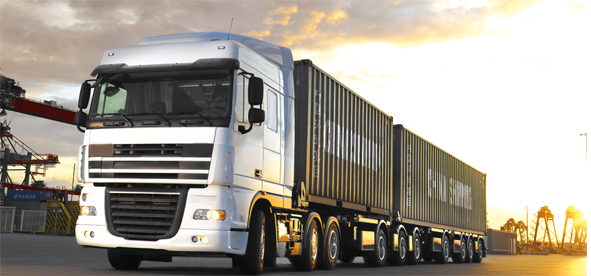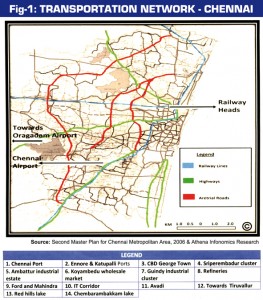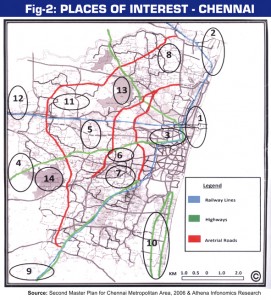Chennai has the fourth largest gross meropolitan product in the country and is an important centre for trade and commerce in the South. The growth of Chennai is driven by the increase in movement of commodities facilitated by the ports and the inter-connected rail and road network. Expansion in economic activities and the prevalence of international trade connections has made it a sought-after investment destination in the country, especially for automobile, electronic and many manufacturing units.
A large number of automotive companies such as Hyundai, Nissan-Renault, Mitsubishi and Ford have already set up plants in Chennai, accounting for 60 per cent of the automobile exports from the country. Chennai has a market share of around 30 per cent of India’s automobile industry and 35 per cent of the auto components sector. There are several small and medium manufacturing units, many of which ancillary to the major industries dispersed all over the metro region, besides the Guindy and Ambattur industrial estates.
Transportation network: An overview
Today Chennai has become the gateway for domestic and international trade in the South. Goods are both consumed as well as transported to and from the region. The shipment centers in the ports, airport and the railway heads rely heavily on movement of goods and traffic in the metropolitan region, and the ability to move these goods has become crucial in maintaining the efficiency of the industries concentrating in and around Chennai.
The other aspects that need attention simultaneously are the safety in commuter movement, environmental aspects as well as the mitigation of climate change factors. The city is served with a system of ring and radial road networks.
Its road network comprises National Highways that converge and run through the city, viz., the NH 4 connecting Mumbai and Chennai (Periyar EVR Salai), NH 5 running between Chennai and Kolkata, NH 45 or the Grand Southern Trunk Road between Chennai and Trichy and beyond, along with an inner ring road, national highway bypass, and an outer ring road that is being built.
The East Coast Road and the old Mahabalipuram road connects Chennai to Pondicherry and Cuddalore. NSK Salai (Arcot Road) and Kamarajar Salai are the other important road arteries in the city.
Chennai Central, Basin Bridge, Salt Cotars, Royapuram and Egmore stations connect the city with the rest of the country and facilitate movement of people, goods and services. The Chennai Domestic International Airport located on NH 45 is the third busiest airport in India and has a separate cargo complex that enables export and import of goods. It is also close to the Madras Export Processing Zone.
New greenfield airport
A new greenfield airport is also now being planned at Oragadam with a capacity to handle 40 million passengers. Complementing the rail, road and air network, Chennai has a fairly advanced port infrastructure. This includes the highly developed Chennai Port close to the Central Business District, Royapuram fishing harbour to the north of Chennai Port, and the recently set up Ennore and Kattupalli Ports, all to the north of it. There is also a proposal to develop a port south of Chennai at Mugaiyur.
Chennai has the maximum number of container freight stations in India, 28 of which are in operation currently with most of them being located in the northern and western parts and three more to be built soon.
The existing network spread across rail, road, air and sea transport has been playing a crucial role in the city’s economic growth. The revenues generated from export and import of trade at the ports and airport totalled Rs. 17,000 million in 2010-11.
Goods & freight movement
The road, rail and the arterial network of Chennai shown in figure 1 indicates the highways and the important roads in green, railway lines in blue and the arterial roads in red. Whenever there is movement of goods to the points of trade the loads are carried by trucks passing through the arterial roads to the points along the major roads.
In addition to the airport and railway heads there are many places of importance that spread across the city to and from which goods are transported.
Figure 2 shows the places of high importance in Chennai. They include sea ports located on the east coast, the Ambattur and Guindy industrial estates in the centre, the IT corridor on the south-east and the automobile manufacturing industries located in the south-west. Movement of goods from these centres primarily takes place on lorries and trucks along with other means of road transport, including auto rickshaws. The materials that are transported include manufactured goods, building materials, industrial raw materials, perishables and parcels.
Location of a few wholesale markets within and around the city also means that there is a continuous movement of vehicles that carry loads through the community points to the receiving and dispatch centres. Community points include commercial as well as the moving points for ordinary citizens. An important factor to be considered during transportation of freight is the traffic congestion caused.
In Chennai, over the last few years there has been a big surge in the number of vehicles plying on roads, resulting in an increase in per capita trip rates (costs) as well as increase in the travel time. Accompanying the increase in traffic on roads, there is pollution from these vehicles that affects the environment as well as people. In this scenario, it has become important to understand the changes occurring in the vehicular population and the after-effects of such an increase.
Motor vehicle movement & pollution
The use of motor vehicles for transport of passengers and goods has increased significantly during the last few years. As against 12.5 lakh registered vehicles in Chennai in 2001, there are approximately 35 lakh vehicles registered in 2012. The annual growth of vehicles on an average has been around 10.8 per cent over the last 10 years.
The State Transport Authority notes that while the number of buses routing in Chennai remained almost stagnant, two-wheelers experienced a remarkable increase in number from 87,000 (1984) to 17,52,101 (2012) registering an annual growth rate of 12 per cent. Similarly, the number of goods carriages increased from 6,671 in 1980 to 79,203 in 2005, also registering a growth of 12 per cent. Such an increase has not however corresponded with a proportionate expansion of road infrastructural facilities. The expansion in road network has not been commensurate with the rising vehicular traffic, resulting in an explosion in vehicular density, increase in peak hour traffic leading to traffic jams and an increase in pollution and delays in movement of goods.
The multiplier effect of such an increase has been visible not only on the arterial network but also on the secondary city network. This is because of the mixed land use patterns observed in the metropolitan area. The trucks that carry loads to shipment centers often pass through the same commercial areas and markets that already experience heavy vehicle movement from other vehicles (such as auto rickshaws) carrying supplies to malls and departmental stores. The simultaneous movement of these two, in conjunction with the daily passenger traffic, is leading to severe inefficiencies and even increasing the number of road accidents.
In the last 10 years, on an average 5,000 people have been prone to accidents each year. Accident data also reveals that on an average 620 persons die on city roads annually. Apart from road accidents, another important consequence of increase in motor vehicle movement is the growing air and noise pollution.
Pollution from vehicular has caused serious harm to the environment and the health of people. With a congested road network pollution is set to increase further. A study carried out by the Tamil Nadu Pollution Control Board reveals that the emission from just half the vehicles in the city already exceeds the permissible limits.
Besides air pollution, there is also noise pollution caused by both passenger and heavy vehicle movements. This has had its adverse effect on the quality and life of the city residents.
With these bottlenecks in road transport network and the impending challenge for achieving efficient transport of goods, the policy discussion should center around development of an efficient holistic road transportation network. The thrust of Vision 2023 of the Tamil Nadu Government is on establishment of several small and medium enterprises and ancillary industries, creating SME clusters in and around major manufacturing units. Most of these industries would be located within the city limits. This reinforces the urgent need for an advanced urban road transportation network that complements the growth of these industries.
Integrated freight master
As has been generally observed, trucks use city roads for mobilizing freight and goods to shipment centers. Increasing motor vehicle movement, improper road linkages and the resulting traffic congestion hit the overall transport efficiency. In order to make the arrangement efficient there must be a strategic and viable plan for reducing inefficiencies in road transportation network. This is possible only through policy and programmable interventions.
The deficiencies in the road transport network in Chennai have been identified as poor quality riding surface, missing links in crucial areas in the road network, mismatch between the growth rate of vehicles and road infrastructural facilities, highly mixed traffic on arterial as well as secondary roads, and reduction in the effective use of road space due to several reasons, including encroachment.
While there have been examples in the past when sincere efforts were made to decongest freight traffic within the city, they were mostly piecemeal in nature. For instance, the inner ring road that was built in the 1980s to improve truck and freight movement between inter-connecting national highways. The arterial road that was built aided efficient movement of goods in the early stages of the city expansion. However, as the city grew, the road was subsumed into the city’s road network, leading to severe traffic congestion. In order to decongest another Chennai Bypass had to be built.
There are several such cases wherein elevated roadways have been considered to tackle inefficiencies. While these measures provide relief to freight carriers in the short term, they do not interact with the larger system, resulting in distortions in the transportation network and increase in the net deadweight loss to the city at large.
Case studies conducted on implementation of urban freight transport exhibit an important element in the integration of the road transportation network. One such case is the portland freight transportation plan that recognized the need to have better freight transportation by understanding deficiencies and developing solutions. Some of the important aspects focused in the plan include evaluation of freight transportation policies, identification of freight mobility improvements and development of freight mobility projects in alignment with the people’s needs in the city of Portland.
The case of Seoul Metropolitan City is also very appealing. The total freight volume reached 6,52,000 tonnes a day in 1996. Truck vehicle traffic at the major expressway and the arterial roads accounted for 20 per cent of the total road vehicle traffic. Trucks were plying onto the arterial roads causing several traffic jams and inefficiencies.
In 1998 the Seoul Metropolitan City undertook a large-scale research project to work out an improvement plan for urban goods by collecting urban freight movement within and around the city. Based on the research project, the metropolitan authority adopted the urban goods transport plan and even constructed new freight distribution facilities that improved truck operations and allowed the dual usage of roads by passenger cars and trucks. Further, there was also a provision of on-road and off-road loading facilities for trucks.
These case studies clearly stress the importance of urban freight transportation plan integrating the elements of mobility, safety, efficiency and sustainability. Thus any proposed integrated transportation plan for improved freight management should focus on three broad themes, namely, mobility & economy, safety & livability, and environment.
Way forward
Transportation is an important aspect of development in any region. Chennai, with its a high density of population, growing boundaries and an escalating vehicular base, requires an effective transportation system to manage its resource flow. With increasing concentration of manufacturing and its ancillary industries in and around Chennai, the need for a transportation network that balances goods and freight transportation together with passenger vehicles is essential.
As per WHO standards, Chennai, because of overcrowding, has exceeded the pollution limits by more than three times accounting for 60 microgram per cubic meter of suspended particulate matter. Carbon emissions from vehicles account for nearly one-third of the total air pollution.
An ideal way to reduce pollution is to use road transport only when it is necessary, making it sustainable. Trucks that carry goods and freight also interact with passenger movement making it difficult for both parties. Development of freight centers concurrent with an integrated road network providing separate lanes for trucks and modes of passenger transport could be beneficial.
An ethical base for providing an efficient, safe and green mode of transportation network can be provided by implementation of sustainable transport policies. Policies adopted so far have placed little emphasis on this aspect. The data availability and planning for transport policies for freight transport is also outdated.
With the explosion in goods traffic in recent years and the setting up of several container yards, heavy truck movement between transport terminals is indeed a necessity.
An Integrated Transportation Master Plan is an urgent need for the metropolitan region of Chennai to make it a world class city with an efficient transportation network, where goods and passenger traffic interact seamlessly; a carbon neutral city, with significantly lower CO2 emissions; and a safer city for both passengers and goods movement through well-designed regulatory/policy mechanisms.


